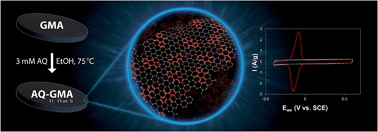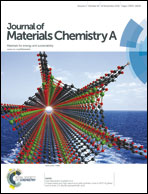Battery/supercapacitor hybrid via non-covalent functionalization of graphene macro-assemblies†
Abstract
Binder-free, monolithic, high surface area graphene macro-assemblies (GMAs) are promising materials for supercapacitor electrodes, but, like all graphitic carbon based supercapacitor electrodes, still lack sufficient energy density for demanding practical applications. Here, we demonstrate that the energy storage capacity of GMAs can be increased nearly 3-fold (up to 23 W h kg−1) by facile, non-covalent surface modification with anthraquinone (AQ). AQ provides battery-like redox charge storage (927 C g−1) without affecting the conductivity and capacitance of the GMA support. The resulting AQ-GMA battery/supercapacitor hybrid electrodes demonstrate excellent power performance, show remarkable long-term cycling stability and, by virtue of their excellent mechanical properties, allow for further increases in volumetric energy density by mechanical compression of the treated electrode. Our measured capacity is very close to the theoretical maximum obtained using detailed density functional theory calculations, suggesting nearly all incorporated AQ is made available for charge storage.

- This article is part of the themed collection: 2014 Journal of Materials Chemistry A Hot Articles

 Please wait while we load your content...
Please wait while we load your content...